|
Articles from the College's first students'
union magazine. Thanks to David Parsons, who has a
copy of the magazine. |
|
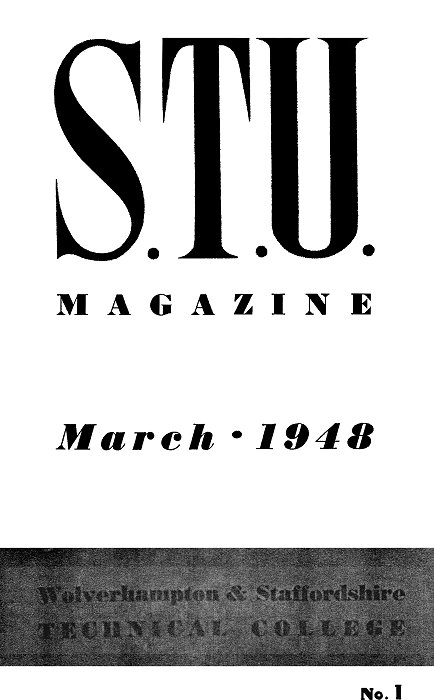
The front cover. Courtesy of
David Parsons. |
|
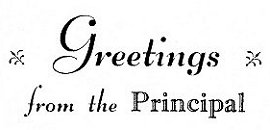
Greetings to the
S.T.U. Magazine and to all who have
played a part in bringing it into being;
to the Editor and contributors, of
course, but to many others also. We
should need to go far back to recall
everyone who has thought of it, hoped
for it, and by varied service to the
Union helped to make it possible now.
Long ago the then
Secretary, Mr. A. S. Jordan, cherished
the idea of the Union magazine. But our
one ready writer of those days, like
Shakespeare, spent his time in writing
plays for his own company. The College
was not so large, and its activities did
not cover so wide a field then as now,
when surely an Editor can find someone
who knows something about anything. I
expect that some of us thought that the
job of running a magazine, might come to
be divided among too few workers. In any
event no magazine was started.
Today, my colleague
Dr. Henderson, himself a practised
writer, has again urged this time upon a
willing Council, the value of an organ
which will bring together in thought, as
the parent Union exists to bring
together in person, students of every
type and every interest. Mr. Bendall, a
recent Chairman of the Union, and over a
period of years the leader of its
Dramatic Society, readily undertook the
honourable but difficult role of first
Editor. With the assured backing of the
Council and members, the Journal can
certainly look for the success which I
sincerely wish it.
It is fitting that
today the Chairman of the Union should
be the once lone champion of the College
magazine; Mr. A. S. Jordan.
W. E. FISHER. |
|
|
The College
Principal's address on page 1. Courtesy of David
Parsons. |
|
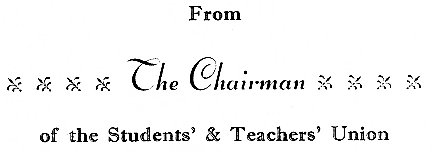
This long-awaited
and often discussed College Magazine has
now appeared, and we all hope it will
become a regular feature of the Union's
activities in and out of the College.
The Students' and Teachers' Union with
its total Membership of over 4,000,
embracing all shades of thought and
opinion, has an important place in the
life of the College, and your Union
Council are pursuing their task of
management of the Union with zeal and
enthusiasm.
If this Magazine
helps still further to bring before the
Student the immense possibilities and
scope of the Union, its sponsors will be
amply rewarded for all their efforts. We
are all very proud of our Union, and
prouder still of its purpose. May this
College Magazine impart a little of that
pride to all Members. The Students' and Teachers' Union is
first of all a democratic organisation,
voluntarily administered, and governed
entirely by the members themselves
through their elected representatives.
It exists to provide and promote social
activities, sports facilities, and
generally to cater for the benefit and
general requirements of all Students and
Teachers outside the normal
instructional life of the College. The
Union is the negotiating body with the
College Governors and the Education
Authorities, and many responsibilities
are delegated to it, including the
management of the College Refectory.
By virtue of a resolution of the College
Governors in 1933, the nominal
registration fee payable each year by
all students is allocated to the funds
of the Students' and Teachers' Union,
and this forms the main source of the
Union's income. An Annual Subscription
is fixed for Teaching Staff membership,
and the majority enrol as members. Four
seats on the Union Council are allotted
to them. By the registration fee
arrangement, all students are admitted
automatically to membership of the
Union, whereas prior to 1933 membership
was purely voluntary, and was actually
about one fortieth of its present
number.In 1933 a new Constitution was
drawn up for the Union, and now at the
beginning of each Session, elections are
held through the College for the office
of Chairman of the Union, and for the
twenty-two Departmental
representatives' seats on the governing
Council. The new Council then meets, and
elects its Honorary Secretary, Honorary
Treasurer, and various subcommittees to
deal with finance, the management of the
College Refectory, Common Room, sports
and social activities, and their reports
are presented to the Union Council at
its monthly meetings. The Principal of
the College, Dr. W. E. Fisher, O.B.E.
(or his nominee) is an Ex-Officio Member
of the Union Council, and the S.T.U.
owes much to his wise counsel and
genuine interest in Union affairs.
Generally speaking, the social
activities of the S.T.U. are
self-supporting, but the continued
development of the Sports Section, with
all the needs and requirements of its
various teams, is a substantial and (we
all agree) necessary charge on Union
funds. The Sports Section holds a front
place in local sporting activities.
The College Refectory, providing
reasonably-priced meals and
refreshments, is also guaranteed
against any possible loss. Overhead and
replacement costs naturally form a
considerable item of expenditure, but as
far as possible the Union's policy is to
administer the Refectory for the full
benefit of all students and teachers,
without profit or loss. Other activities
are also financially guaranteed where
necessary. There are also Affiliated
Societies of the Union functioning in
the College, including an active
Dramatic Society.
As the Union is a voluntarily-run
organisation, the general administrative
expenses are comparatively small, and
every assistance is afforded for
promoting new activities where the
necessary support is forthcoming.
The Union encourages new students to
take an active interest in Union
affairs, and holds a Freshers' Welcome
at the commencement of each Session to
introduce "Freshers" to the life of the
College. It also admits to Membership
on payment of an annual subscription,
former Students of Organised Courses of
the College, and many old students
retain their connection with the College
and the Union by this means. They are
allotted three seats on the Union
Council, and when old students meet at
Annual Soirees, many happy days are
recalled.
During the war years, the activities
of the S. T. U. were naturally
restricted, but kept going, and the
future is full of promise for this
time-honoured organisation, which has so
definite a place in the life of our fine
College.
A. S. JORDAN,
Chairman. |
|
|
The
Chairman's address. Courtesy of David
Parsons. |
|
The Students and Teachers
Union Council, 1947 to 1948 |
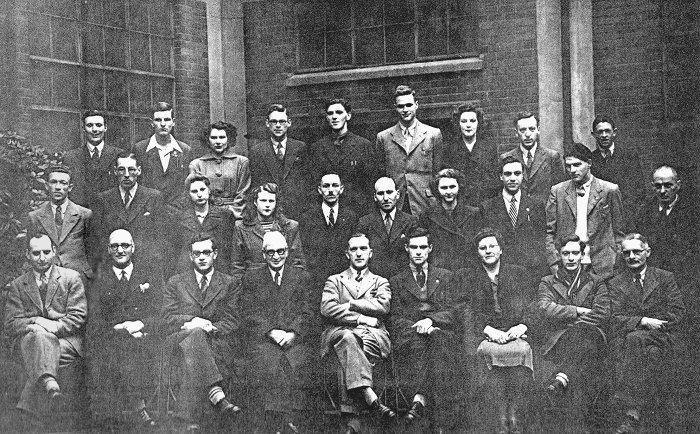 |
Back row, left to right: W.
B. Fellows, E. Waldron, Miss
S. M. Wilkes, F. C. Bate, F.
Morrison, F. H. Anderson,
Miss M. Cooper, J. Williams,
?
Middle row, left to right:
N. Barnett, D. Roberts, Miss
S. Waldron, Miss J. Nichols,
B. Thomas, J. W. Pool, Miss
P. Whistance, ? D. H.
Westwood, ?
Front row, left to right: E.
Wells, F. Gobourn (Hon.
Treasurer), J. C. Bennett
(Asst. Hon. Sec.), Dr. W. E.
Fisher, A. S. Jordan
(Chairman), A. J. Locke
(Hon. Sec.), Mrs. M. Fownes,
J. Grieve, ? |
|
|
Courtesy of David Parsons. |
|
Technical
Education in Wolverhampton
Part 1. Dr. W. O.
Henderson.
One of the many
results of the Industrial Revolution was
that new methods of technical education
had to be devised. In the days when the
craftsman worked in his own home, or in
a small workshop, the apprenticeship
system gave the necessary technical
instruction to one generation of young
workers after another. A small number of
apprentices worked under the immediate
supervision of a master craftsman, who
was responsible both for their technical
training and for their general well
being. But when huge factories
developed, and many of the formerly
independent craftsmen became "hands" who
tended machines, the old apprenticeship
system could no longer be worked
satisfactorily. Eventually, with the
establishment of science classes and
technical colleges, new methods of
training were devised to suit the
industrial age. The young worker was
trained partly in the factory and partly
in the new technical schools. In the
engineering and metal trades of the
Black Country the small workshop
survived far longer than in the great
textile centres of Lancashire and
Yorkshire. Nevertheless, here, too,
large factories appeared in which the
old apprenticeship system had to be
replaced, or drastically modified by the
introduction of new methods of training
young workers. Among the larger works in
Wolverhampton in the early and mid
nineteenth century were the Shrubbery
Ironworks (Thorneycroft), the
Chillington Ironworks (John Barker), the
japan works of Walton & Company (at the
famous Old Hall), Shoolbread and
Loveridge, Edward Perry and others, the
paint works of Charles Mander, the toy
works of Evans & Cartwright (at Whistle
Hall), the enamel works of the Jones
Brothers, and the lock manufactory of
Chubb.
Wolverhampton was
not so fortunate as Birmingham, where
Sir Josiah Mason's munificent gift of
£180,000 enabled a Science College to be
opened in 1882, which, twenty years
later, developed into a University.
Lacking financial help of this kind the
origins of technical education in
Wolverhampton took the form of much more
modest ventures.
Two factors in the
early development of technical education
in England deserve notice. First,
scientific and technical studies began
as part of general education. Secondly,
the early provision of adult and
technical education was almost entirely
by private enterprise. Neither the State
nor the Local Authorities played any
significant part in promoting technical
studies until the last decade of the
nineteenth century. Funds were raised by
public subscription and by students'
fees.
Wolverhampton was
affected in the nineteenth century by
two important voluntary movements which
promoted adult education, they were the
Mechanics' Institutes and the Working
Men's Colleges. Professor Birkbeck
established classes for "mechanics" at
Glasgow University, and lectured
successfully on the mechanical
properties of solids and fluids to large
audiences of working men. After he left
Glasgow, his students established an
independent institution of their own
(1823). Three years later a similar
institution was started in London. By
1850 there were over 600 mechanics'
institutes in the country. In
Wolverhampton a Tradesman's and
Mechanics' Library was established in
1835, which developed from an earlier
library of 1827. The mechanics' Library
offered its members popular lectures as
well as a reading room and facilities
for borrowing books. On its premises an
important exhibition of local art and
crafts (one of the first of its kind in
the country) was organised by George
Wallis in 1838. The active life of the
Mechanics' Library was a short one, for
by 1845 its membership had declined and
it was in debt. In 1847 it was revived
as the Mechanics' Institute but again
its active life was a short one, for by
1850 its committee reported that "the
Institution was not receiving that
support from the public which it
deserved."
While mechanics'
institutes had perhaps an unduly
utilitarian outlook, the working men's
colleges of the fifties, inspired by F.
D, Maurice, the Christian Socialist,
stressed humane and moral studies,
though technical classes were not
neglected. In Wolverhampton, Henry
Hartley Fowler, a rising local
politician, a future Mayor and a future
Cabinet Minister was actively interested
in the founding of a Working Men's
College (1857).
At the first annual
meeting of the College, Fowler discussed
the aims of adult education on lines
which are by no means out of date. He
said that the aim of adult education was
not to turn working men into scholars,
but to improve their competence as
craftsmen and their value to the
community as citizens. Regard the
influence of this education in respect
to the relation of the working man and
his master. Depend upon it that it will
be the dawn of a better day for masters
as well as workmen, when workmen
understand the why and wherefore of
their work, the principles of that
mechanism.
There were only 45
students and the funds available
amounted to no more than £65. In the
following year the enterprise came to an
end. Another educational institution of
some importance a century ago was the
School of Art, originally established in
Castle Street in 1851. Shortly
afterwards £4,000 was raised for a new
building in Darlington Street which was
opened in 1854. The school was in
difficulties for a time, but in 1873 it
had 173 students. In 1885 it was merged
into the new Municipal School of Art.
In the seventies
the Corporation at last began to make
some modest provision for adult and
technical education. The Town Council's
Free Library was opened in 1870 in Queen
Square. It had some 2,000 volumes from
the Mechanics Institute and a small
library from the Working Men's College.
In August 1872, the Free Library was
moved to the premises formerly used as
the "Public Office" (police station and
fire brigade) in Garrick Street.
In that winter,
John Elliott, the able and public
spirited first local municipal
librarian, established regular evening
Classes in a variety of technical,
scientific, commercial and general
subjects. It has been claimed that the
Wolverhampton Library was "the first
among all the other Free Libraries to
set the example in this direction." The
number of enrolments in the first
session was 348. The students were
normally over 14 years of age, but there
were exceptions, as in the case of the
eleven years old boy who studied music
and gained a choristership at an Oxford
College.
Part
2, 1883-1911. G. F. Chell, Esq.
When I joined the
Free Library Staff as a Junior in 1883,
the Free Library Classes, as they were
then called, were firmly established.
Commenced in 1873, 21 classes enrolled
about 270 students; by 1883 the student
entries were 945. John Elliot,
Wolverhampton's first Librarian, acted
as Secretary, and it was largely due to
his ability and enthusiasm that the
classes developed and made such
progress.
The building in
which they were housed was situated in
Garrick Street, on the site now occupied
by the Savoy Picture House. Prior to its
use as a Library it had been the Public
Offices, including Magistrates' Court,
police quarters, and cells for
prisoners. After their removal to the
present Town Hall the building did a
short spell as a hospital, during an
epidemic. Owing to the generosity of Mr.
Isaac Jenks, who was Mayor of the town
1872-3, the prisoners' cells were
converted into a classroom, and will be
remembered by many of the older
residents of the town as the Jenks Room.
This was reserved for the science
classes, and it was in this room also
that the Popular Saturday Evening
Lectures started in 1875. The cost of
meeting in dull, dark rooms, with scanty
equipment, was partly maintained out of
the Library Rate, which was one penny in
the pound, producing in 1874 about £800.
In 1896 a report on the educational work
of the Town Council admitted that the
Garrick Street premises were "perhaps
one of the worst Free Library buildings
in the country, for a town of this
size." They were inadequate when
compared with those of the College, but
provided a measure of practical
instruction of which keen students made
good use. Three examples of this
keenness of youths, who with only the
elementary education of that day,
climbed the ladder of success: Francis
Watts, whose special subject was
Chemistry, secured an appointment in the
West Indies, became a member of the
Legislature, and was subsequently
knighted for his services; Charles M.
Webb, whose special subject was
Mathematics, won a Scholarship to
Cambridge University, gained a post in
the Indian Civil Service and after a
long and distinguished service in Burma,
including the Vice-Chairmanship of
Rangoon University, retired with the
decoration of K.C.S.LE.; Charles Jefcoat,
a fitter, attending classes in
Engineering, at one period actually
earning five
evenings each week, journeying to
Walsall and Birmingham for subjects he
couldn't get in Wolverhampton, gained a
Whitworth Scholarship, and became
Principal of a Technical School in
Ireland. These are typical examples of
results achieved by the students who
were determined to acquire knowledge.
The social life of
the College began to develop in 1883
when, at the suggestion of Alderman
Joseph Jones, the Chairman of the Free
Library Committee, a reunion after the
Christmas vacation was held on January
7th, the whole building being occupied
by exhibits and entertainment. The
Wolverhampton Telephone Exchange was
then housed in a room at the top of the
building, and here a number of receivers
were fitted and connected with Walsall,
where an entertainment was being given.
The attendance was limited to students,
and the profit, about £6, was given to
the Prize Fund. This became an annual
event. In 1886 it was held in the
Exchange Hall, dancing being included,
and students were permitted to introduce
a friend.
As more
accommodation was required, the 1887
Soirée was held in the Drill Hall,
Stafford Street. Each succeeding year
seemed to add to its popularity and on
one occasion it was estimated that 1,200
persons were dancing in the large Hall,
while entertainments, scientific
experiments and exhibitions were being
held in the other rooms. It was here the
first flashlight photograph of the Dance
Hall was taken by two enthusiastic
students and some hundreds of copies
were sold.
In 1902 the Library
moved to the building in Cleveland Road,
leaving more space for the Classes now
known as the Science and Technical
School. By partitioning rooms, more
accommodation for classes was provided
and new subjects were added to the
programme. In 1903 the Education Bill
brought the work under the Education
Committee, and the late Councillor A.
Weaver, a former student, who became
Chairman of the Technical Sub-Committee,
a position he occupied until his death
in 1917. Dr. J. Denis Coales was
appointed the School's first Principal
in 1911,
Social activities
rapidly extended from 1903. The
Student's Reference Library was formed,
Sir Alfred Hickman and others made
donations of books and money, whilst the
Students and Teachers Union, recently
formed, made grants from its funds, which
were accumulated from the members'
subscriptions, profits on the annual
Soirée, March Social, Annual Excursion
and the Reunion held immediately prior
to the opening of the new Session
Students' Societies within the Union,
which began to be formed, comprising
Engineering, Dramatic, Debating, Cercle
Francais and Chemical.
In this old and
shabby building, with inadequate and out
of date equipment, dubbed by the
Inspectors of the Board of Education,
The Rabbit "Warren," the Science and
Technical School continued to thrive,
but those who worked in it, looked
forward to the time when a new building
and equipment worthy of the town should
bring youth its fuller opportunities for
further education:
The technical and
commercial classes were then scattered
in Garrick Street, Dunkley Street, Old
Hall Street and elsewhere. Two thirds of
the capital charges were to be met by
the Borough and one third by the county.
The running costs of a new college were
to be shared according to the number of
students attending the college from each
area.
The scheme for a
new technical college was
long delayed, first by the war of
1914-18, and then by a lively
controversy over the proposed demolition
of the historic Deanery House to make
room for the new buildings. The Deanery
was a fine example of late seventeenth
century domestic architecture, and may
have been built from a design by Sir
Christopher Wren. Its most famous tenant
had been William Wood, the Staffordshire
ironmaster who had lived there for 21
years, (1692-1713). Every schoolboy
knows how Wood's patent for making
copper halfpence for Ireland was
attacked by Swift in The Drapier
Letters, and how Walpole ultimately
cancelled the patent. Another well-known
tenant was William Parke, bookseller and
newspaper publisher, who lived at the
Deanery from about 1851 to 1876. He has
been described as a "man of learning,
education and culture" who entertained
largely at the Deanery and was visited
by and on terms of friendship with many
of the leading men of the day.
Charles Dickens
visited Parke at the Deanery in 1858. It
is of interest to recall that Ellen
Thorneycroft Fowler in her novel A
Double Thread referred to "Silverhampton's"
Deanery. It was, she wrote, "panelled
throughout with black oak, and boasted
one of the finest carved staircases in
the County." Between 1877 and 1904 the
Deanery was used by the local
Conservative Club, and many leading
statesmen were entertained there.
When the
Corporation bought the Deanery House and
its grounds for educational purposes,
strenuous efforts were made to secure
the presentation of the building, which
was one of considerable architectural
interest. It was suggested that the
house itself might be adapted for use as
the administrative offices of the new
Technical College, while laboratories
and classrooms might be erected in the
grounds. This scheme was however
eventually rejected, partly because of
the expense involved. The Ecclesiastical
Commissioners who had owned the property
between 1848 and 1912 had sadly
neglected the premises, and partly
because of the undesirability of having
the administrative and teaching portions
of the proposed College in separate
buildings. After further delays the
Board of Education held up the scheme in
1921 on grounds of economy, the Deanery
House was pulled down. The Board Room of
the Technical College contains panelling
removed from the old Deanery House.
In 1922 the
antiquated Garrick Street premises, in
which some classes were still held,
threatened to collapse, and the Board of
Education then agreed to the erection of
the present Engineering Block on the
Deanery site. In 1933 the rest of the
existing buildings were opened. The
number of students rose from 837 in
1922-3 to 1,632 in 1930-1 and over 4,000
in 1946-7.
If the early
history of technical education in
Wolverhampton can boast of no great
figures who dominate the scene it had
many pioneers whose labours deserve to
be remembered. Present day students at
the Technical College owe a debt to men
like H. H. Fowler who inspired the
establishment of the Working Men's
College, John Elliott who founded the
Free Library science classes, Alderman
Jenks who found the money for the first
science classroom, Joseph and John Jones
who gave the land on which the chemistry
laboratory in Garrick Street was built
and Alfred Hickman who subscribed
generously to the fund for erecting the
first metallurgical laboratory. It is
largely to the work of such men and to
several generations of teachers and
officials that Wolverhampton owes its
present system of technical education. |
|
|
Courtesy of
David Parsons. |
|
Recollections…. Rugger Club
The first authentic record of a
Rugby match in connection with the College takes us
back to the winter of 1932, when a scratch side was
raised to play Tettenhall College on the Newbridge
Memorial Ground. The result was a win for Tettenhall
College by 8 pts, to 6. Of those who took part,
several names stand out in the memory. The Tech,
team was captained by H. L. Haslegrave at stand-off
half, now Principal at Leicester Technical College.
His partner to work the scrum was Alan Pritchard of
golfing family fame, who, about half-time, had the
lobe of his ear torn, and bears the scar today. His
place was taken over by Don Murphy, now somewhere in
South Wales. The three-quarters included Turner,
from Walsall, and E. G. Singleton, now helping to
run our local transport system. The writer of this
article was the last line of defence at full-back,
and he missed converting the first try, or we might
have drawn the game. The arrangement was that Turner
and myself should exchange positions at half-time,
but this never happened, probably owing to our
respective merits in our original positions. I
wonder however we lost!
Others I can remember were H.
B. Wright, an outstanding forward, very prominent in
the line-out; and another whose name has slipped
memory but whom I next ran into halfway through the
war, after he had been on the 'Ark Royal' when
torpedoed. After the match we were entertained at
Tettenhall College, and enjoyed ourselves in their
swimming bath. Of their team I remember C. McLachlan,
who scored one of their tries and who eventually was
brought down over Germany in one of our early raids
and was a prisoner of war for several years. He is
still playing for Wolverhampton and occasionally for
North Midlands.
The next period started in 1937
when Arthur Jordan, no Rugger player but a great
organiser, in conjunction with G. Bayliss of the
Wolverhampton Club, got the Club going again. Of the
players who took part in those games I can remember
the Laflin brothers, Harry and John; D. L. Wood, a
flying wing three-quarter; Jim Noble; W. Layman, who
was killed in the assault on Walcheren Island in
1944; 'Peter' Furniss, who is back with us again as
our present Vice-Captain, after seeing military
service in several parts of the Empire; K. Wrigley,
who got badly shattered during the war; and David
Bamlett, scrum-half and also a Hockey player; he was
good at both, and there was keen competition for his
services, but who died as the result of active
service. Our then Secretary, D. L. Wood, eventually
piloted one of the McRobert gift planes in the
Middle East.
Later on the team developed
into a very strong side, including such outstanding
players as Sam Bridge, eventually Captain until he
joined the R.A.F.; Jack and Bill Williams; Ronnie
Mawhood; Jack Ransom; Tony Clark; Ken Baker, a
convert from soccer and a marvellous dribbler, who
has been helping us since his return from active
service and who has now gone as engineer to the City
Transport in Hong Kong; Bob Bayliff; Peter Spice;
Bill Clennel, a sterling full-back; Eric Bentley;
Don Lowrey and Hugh Greehan, who has since qualified
for the Caterpillar Club by having to jump from a
damaged plane while in the R.A.F. Surely this was
the Vintage Year, and we had some marvellous games,
not all of them Rugby!
Then came the war, and our
playing strength gradually faded away; as our
members went in for the sterner game of war, and
there ensued a lean period. However our first batch
of Cadets came along and, after trying to run a Rugger side on their own, they decided to come into
the College club, after which we had a period of
plenty. More groups of Cadets arrived, and we had
too many players from whom to choose.
The job of Hon. Treasurer for
quite a while changed hands frequently, as members,
even after election, went into the forces. However,
we managed to keep financially sound! Some of our
outstanding players in those days were R. W. Charles
from Lydney G.S., Gil Roach, K. D. Hacker, R. J. Kenneison,
G. Lyndon, P. Culverwell, Tich
Cartwright, now a Paratrooper, P. Williams, L.
Johnson, J. Forward, J. Youings and K. Wilson. In
1945-46, R. W. Charles was elected
Captain, as a mark of respect to the
Cadets and as a tribute to his work as
assistant secretary and his ability as a
player. He came to us as a forward, but
we converted him into a dashing
centre-three. In 1946-47 practically all
our players had gone into the forces,
and so we had a hiatus with no team that
season. Then some of our old players
returned and the Club was re-started,
owing to the enthusiasm of L. Johnson,
who got busy and arranged fixtures, and
is now our new Captain. The record for
the current season is given elsewhere,
but in one game at Marsh Lane we had the
unique spectacle of three brothers,
Frank, Terry and Michael Moore all
playing, and their parents, sister and
one wife, all spectators! Good old
Eire!
|
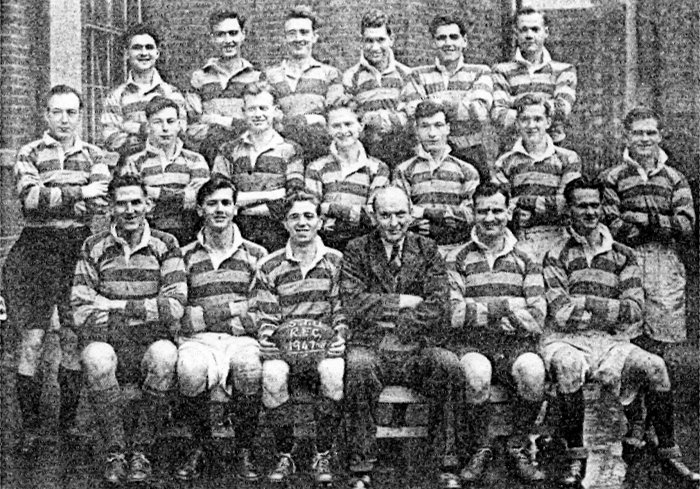 |
|
The 1947
Rugby Team |
Back Row,
left to right:
J. H. Adam, F.
Febrocq, S.
Cross, G.
Lyndon, W.
Withall, D. W.
Hughes.
Middle Row,
left to right:
R. Oakley, R. M.
Higgins, W. D.
Dodshon, G.
Gittins, P. H.
Willliams, M.
Moore, D.
Cornelius.
Front Row,
left to right:
Whitehouse, A.
H. L. Lovell
(Secretary), L.
Johnson
(Captain),
Mr. K. B. Milne
(Chairman), F.
G. Furniss (Vice
Captain), T.
Moore. |
|
At the time of going to press
we can announce that at long last we have procured a
new strip! As our other strip had lasted since 1937,
by the frantic efforts of our war-time committee and
a bit of make do and mend, we can congratulate
ourselves, and we are having our photograph taken in
our new regalia to celebrate, and help illustrate
this first edition of our illustrious journal.
As most of the foregoing
narrative has been written from memory, I trust I
will be forgiven if I have omitted any old player of
distinction. The majority of those mentioned have
become members of H. M. Forces sooner or later, and
as they gradually return to 'Civvy Street' I can
assure them that the College, the S.T.U., and
especially the Rugger Club will be glad to re-enlist
them. Au Revoir! The prolate spheroid is calling
you!
K. B. MILNE.
|
|
|
Courtesy of
David Parsons.
|
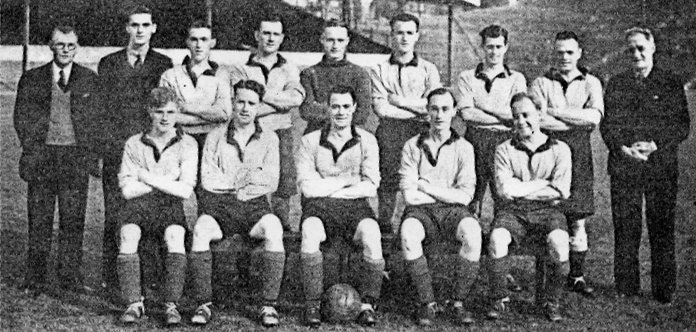 |
|
Football Team. |
Back Row, left
to right: M. Rowley
(Trainer), A.
Robbins, R. Starr,
J. Gough, S.
Robbins, L. Heath,
G. Miles,
A. Clay (Captain),
T. Owen (Committee).
Front Row, left to
right, J. Caulton,
D. Bayliss, W. Owen,
W. Sharratt, A.
Clarke. |
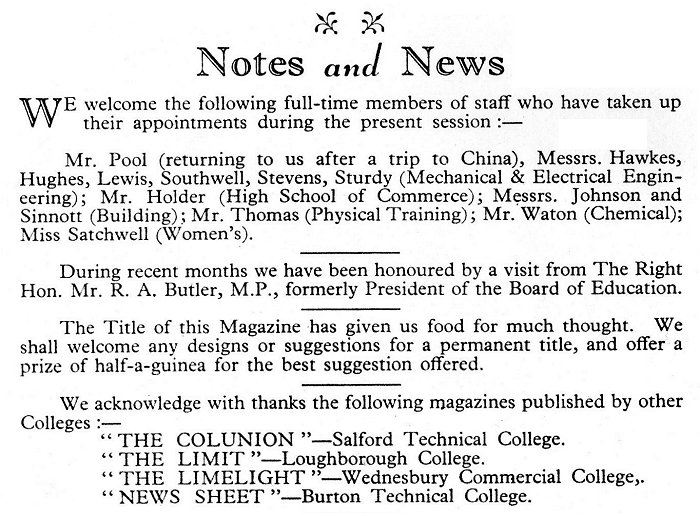
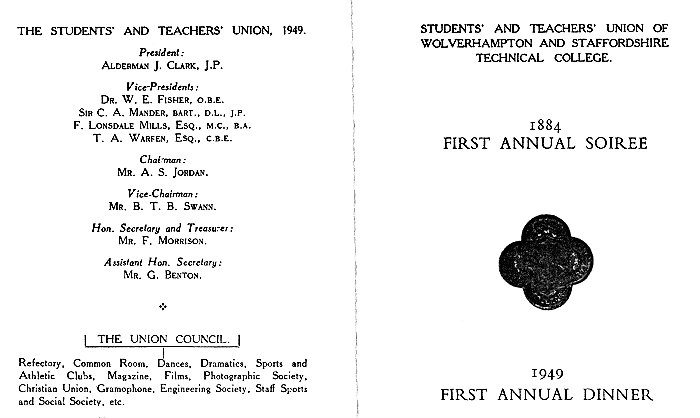
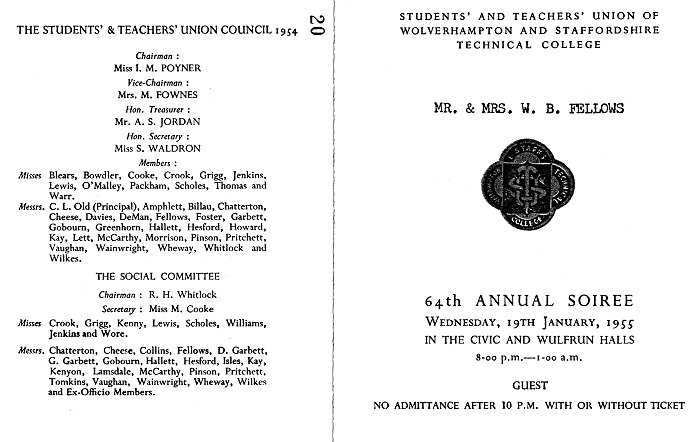
Courtesy of David Parsons. |
|
|

| The Annual Sports
Supper was held on
Saturday, January 24th,
in the College
Refectory. There was an
overwhelming demand for
tickets, and we had to
disappoint many of our
supporters. Among the
visitors were Dr. and
Mrs. Fisher, and Miss D.
Fisher, F. Lonsdale
Mills and Mrs. Mills,
Mrs. Milne, H. J.
Barratt, A. S. Jordan
(Chairman S.T.U.), A. F.
Bendall (Vice-Chairman
S.T.U.), A. J. Locke
(Hon. Sec.), and F.
Gobourn (Treasurer). Mr.
P. Morris represented
the "Express and Star." |
Apologies were
received from Alderman and Mrs. J.
Clarke, Mr. and Mrs. G. Chell, and
Captain Schwabe. Alderman A. Lane
and Mrs. Lane (Mayor and Mayoress)
were unable to be present at the
supper, but honoured us with their
presence at the College Dance which
followed.
Mr. K. B. Milne
(Chairman of the Sports' Committee
proposed) "The King," and "Absent
Friends." F. Lonsdale Mills, in a
very eloquent speech, expressed his
gratification at being invited as a
guest, and thanked the Sports' Clubs
for allowing him to bring with him
Mr. J. Coulter, an Australian
friend, acting in the Moral
re-armament play, "The Forgotten
Factor."
Mr. Mills
promised the Union his full support
in all matters, and further
amplified his promise of a year ago
by informing the Sports Club that he
was hoping to provide two hockey
pitches, two soccer pitches, and one
rugby pitch, on the proposed race
course playing field. His toast,
"The Union," was responded to by Mr.
A. S. Jordan.
Mr. B. Thomas,
Sports Secretary, reported the birth
of new clubs in the Union, and a
renaissance in the life of already
established clubs. His toast "Our
Guests," was responded to by Mr. P.
Morris.
Dr. P. Young,
in proposing "The Sports Club",
charmed his hearers with a very
witty, chatty speech, and Mr. K. B.
Milne responded.
The Secretaries
or Captains of the various clubs
then gave their annual reports, and
Miss D. Fisher presented the "Arthur
Jordan" Cup for the best performance
of the year, won by the Senior
Soccer Team, to Mr. A. Clay,
Captain.
The proceedings
terminated with a vote of thanks,
proposed by Mr. A. J. Lock, to the
Refectory Staff for the wonderful
repast they had provided. |
|
|
Courtesy of David Parsons. |
|
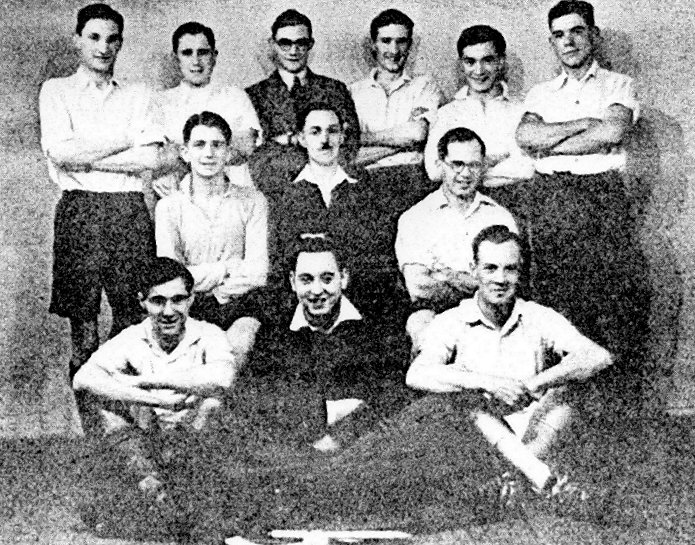
The Hockey Team.
Courtesy of David Parsons. |
|
On Monday, 12th January, the
Students' and Teachers' Union held its
57th Annual Soiree in the Civic Hall.
Classes for that evening were cancelled,
thanks to the Governors, and over 900
attended, a considerable increase in
numbers. The band was Reg. Bartlam's,
and refreshments were provided by
Messrs. Harris.
The evening was a
great success in every way. Some were
lucky enough to win spot prizes; others
danced with abandon; others again joined
those who also serve who only stand and
wait, being content to watch the dancers
from the sides of the Hall.
We were glad to
receive a visit from the Mayor and
Mayoress, who stayed to enjoy the dances
with the rest of us. Many old students
and old friends of the Union came as
guests of the Union or as visitors, and
it was in every sense a Reunion. It is
interesting to record that Mr. and Mrs.
G. F. Chell achieved yet another Soiree;
elsewhere in this Magazine Mr. Chell has
recorded his attendance at the first
Reunion as far back as 1883.
The increased
attendance was a clear indication that,
by returning to a date early in the New
Year, the Union is making the Soiree a
much more popular event. Previous to
1939, it was always on the first Monday
of the New Year, and would have been
this year but for the intervention of a
Symphony Concert. We hope that
arrangements have been made to return,
in 1949, to this favourite first Monday. |
|
|
Courtesy of David Parsons.
|
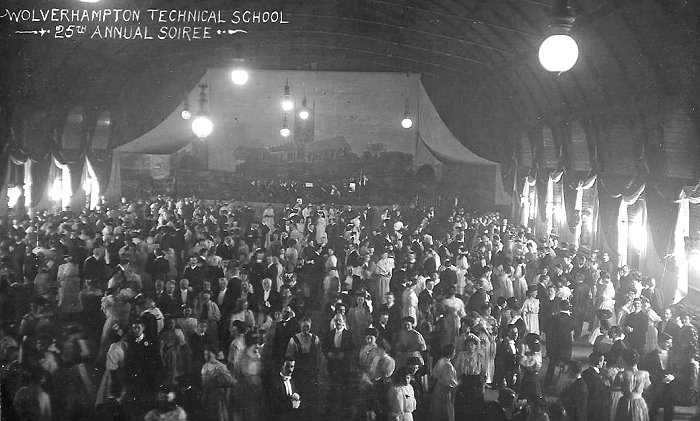
The 25th Annual
Soiree, possibly in the drill hall. From
an old postcard. |
|
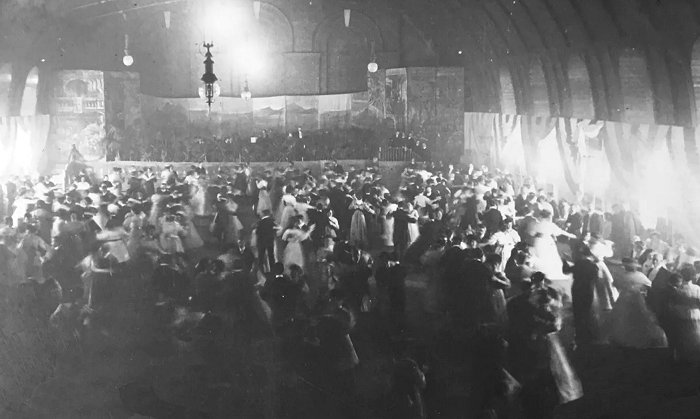
The 26th Annual
Soiree. From
an old postcard. |
|
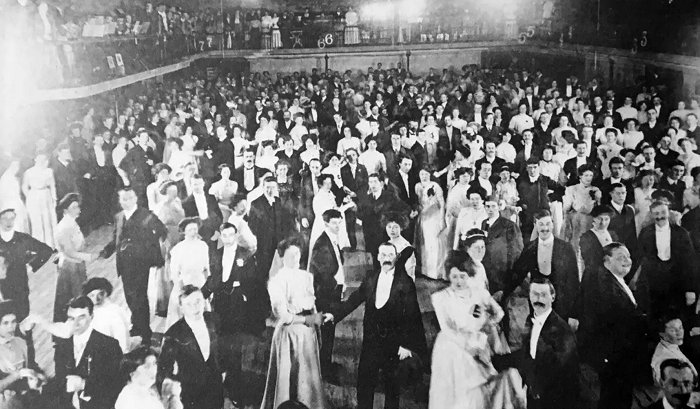
The 27th Annual
Soiree. From
an old postcard. |
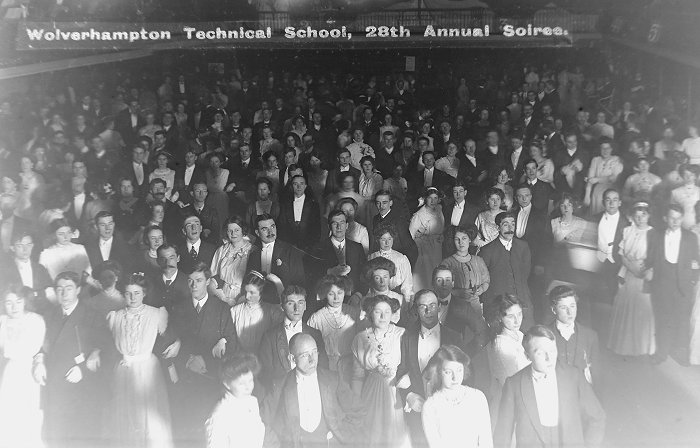
The 28th annual
soiree, held in
the swimming baths assembly room. The
photo is from Cathy Dennis's wonderful
collection, for which she owns the
copyright. |
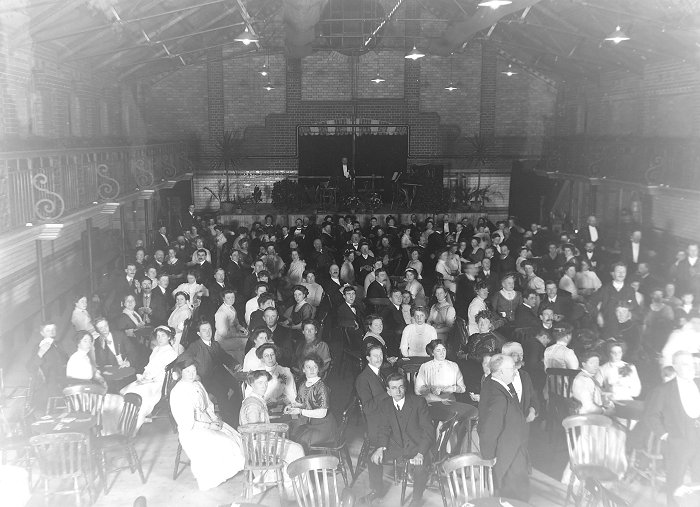
Another annual
soiree, also held in
the swimming baths assembly room. The
photo is from Cathy Dennis's wonderful
collection, for which she owns the
copyright. |
|
 |
Return to the
previous page |
|